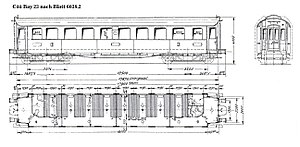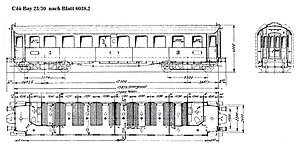C4ü Bay 23
|
C4ü Bay 23 C4ü Bay 23/30 |
|
|---|---|
| Numbering: | 13 106-13 120 |
| Number: | 15th |
| Manufacturer: | MAN |
| Year of construction (s): | 1923 |
| Retirement: | until 1957 |
| Type : | Passage car |
| Genre : | CCü (C4ü) |
| Gauge : | 1435 mm ( standard gauge ) |
| Length over buffers: | 19,125 mm |
| Length: | 17,900 mm |
| Height: | 4,000 mm |
| Width: | 2,940 mm |
| Trunnion Distance: | 12,500 mm |
| Bogie axle base: | 3,500 mm |
| Total wheelbase: | 16,000 mm |
| Empty mass: | 40,500 kg |
| Brake: | Hand brake, Westinghouse brake, Henry brake |
| Train heating: | steam |
| Coupling type: | VDEV screw coupling |
| Seats: | 64 |
| Classes : | III |
The C4ü Bay 23 was a bogie through car with side aisle, the sheet no. 6038 II was built for the Bavarian group administration of the DRG for domestic express train traffic.
procurement
As a replacement for the losses caused by reparations deliveries, the Bavarian group administration of the DRG procured a total of 15 type C4ü cars in 1923 . These corresponded to the wagons according to sheet no. 179. The delivery was made by MAN in Nuremberg.
Whereabouts
One vehicle was taken out of service in 1940, another was converted into the C4ü Bay 23/30 in 1930 . The whereabouts of a total of six cars in 1945 have not been clarified. The remaining cars were retired by 1957.
Constructive features
Underframe
The base frame of the connected to the car body underframe was built entirely of wood, which partially - z. B. for the outer side members - was reinforced with screwed angle iron. Wooden profiles were also used for the cross members. This design promised a smoother run for high-quality cars. The wooden cross members to hold the turntable pans were also reinforced with angle iron. Due to the large wheelbase, trusses with adjustable tie rods were added to support the outer longitudinal members. The buffer beams were built entirely from rolled sections. As a towing device, the wagons had screw couplings with safety hooks according to VDEV, the drawbar was spring-loaded throughout. As a shock device, the cars had case buffers with an installation length of 650 millimeters, the buffer plates had a diameter of 400 millimeters.
drive
To improve the smoothness of running, the cars had long bogies of Bavarian design with a wheelbase of 3,500 millimeters. The frames of the bogies were riveted together from sheet metal and angles. The axles were stored in sliding axle bearings. The wheels had spoked wheel bodies of the Bavarian type 39. The longitudinal springs on nine leaves had a length of 1,250 millimeters with a cross section of 90 mm x 13 mm. Because of the large distance between the bogies, the underframe was supported by a spatial truss in the plane of the outer side members. This could be reproduced. All cars had a handbrake in the closed transition at one end of the car and air brakes of the Westinghouse type , the HARDY system or those of the HENRY system.
Car body
The car body framework consisted of a wooden frame work. It was clad with sheet metal on the outside and wood on the inside. The side walls were smooth and pulled down to the top of the outer side rails. The cars had a barrel roof of southern German design. The roof ends over the drawn-in entrances were rounded.
Furnishing
The interior had a total of eight third-class compartments. Only the two compartments at the ends of the car were closed with sliding doors to the side corridor, the rest were open. As is typical for the class, the compartments were equipped with wooden slatted benches. There were toilets at both ends of the car and a washroom at one end. The cars were heated by steam heating . The ventilation took place via roof vent or via the retractable windows. The lighting was done by gas lamps . A large storage container hung on the frame lengthways. From the 1930s onwards, it was converted to electrical lighting.
comment
When the car was rebuilt in 1930, changes were made in the toilet area and the car received a switch cabinet for the electrics.
Sketches, drawings, photos
Wagon numbers
| Sheet number. Manufacturing |
Generic symbols per epoch Car numbers per epoch (with information about the direction) |
landing gear | Furnishing | Additional information | ||||||||||||||||||||
|---|---|---|---|---|---|---|---|---|---|---|---|---|---|---|---|---|---|---|---|---|---|---|---|---|
|
construction year |
manufacturers manufacturers |
Number |
from 1907 |
Rep. 1919 |
DR (from 1923) |
DRG (from 1930) |
DRG after renovation |
excluded screened |
last. Home letter |
Number Ax. |
Unt. Gest. |
LA. |
Brem- sen |
Bl. | Hz. |
Number off place |
Seats per class (mil. Usage) |
Sig- nal . |
comment | |||||
| Sheet number. 6038 II | C4ü | C4ü Bay 23 | C4ü Bay 23 | C4ü Bay 23/30 | (see respective legend) | 1. | 2. | 3. | 4th |
(see legend ) |
||||||||||||||
| 1923 | MAN | 15th | 13 106 Mü | 26 071 Mü | 18,984 mu | 02/1950 | Munich | 4th | Pl; Wsbr; Hno | Gg | D. | 2 | 64 (848) |
Altschadwagen | ||||||||||
| 13 107 Mü | 26 072 Mü | 18,985 mu | xx / 1945? | Munich | ||||||||||||||||||||
| 13 108 Mü | 26 073 Mü | 18 986 Mü | 12/1955 | Passau | 1955 -> 19 794 Reg | |||||||||||||||||||
| 13 109 Mü | 26 074 Mü | 18,987 mu | xx / 1945? | Munich | ||||||||||||||||||||
| 13 110 Mü | 26 075 Mü | 18,988 mu | xx / 1945? | Munich | ||||||||||||||||||||
| 13 111 Mü | 26 076 Mü | 18,989 mu | 02/1957 | Munich | 1955 -> 19 795 Au | |||||||||||||||||||
| 13 112 Mü | 26 077 Mü | 18,990 mu | xx / 1945? | Munich | ||||||||||||||||||||
| 13 113 Mü | 26 078 Mü | 18 991 mu | 12/1951 | Munich | Altschadwagen | |||||||||||||||||||
| 13 114 Mü | 26 006 Nür | 18 992 Nür | xx / 1945? | Nuremberg | ||||||||||||||||||||
| 13 115 Mü | 26 007 Nür | 18 993 Nür | xx / 1945? | Nuremberg | ||||||||||||||||||||
| 13 116 Mü | 26 008 Nür | 18 994 Nür | 01/1951 | Nuremberg | ||||||||||||||||||||
| 13 117 Mü | 26 003 Reg | 18 995 mu | 10/1948 | Munich | Altschadwagen | |||||||||||||||||||
| 13 118 Mü | 26 004 Reg | 18 996 Mü | 18 996 Mü | 06/1951 | Munich | Altschadwagen | ||||||||||||||||||
| 13 119 Mü | 26 005 Wür | 18 997 Nür | xx / 1939 | Wurzburg | ||||||||||||||||||||
| 13 120 mu | 26 006 Wür | 18 998 Nür | 01/1951 | Wurzburg | Altschadwagen | |||||||||||||||||||
literature
- Alto Wagner: Bavarian passenger coaches . 1st edition. Kiruba Verlag, Mittelstetten 2015, ISBN 978-3-945631-00-3 .
- Emil Konrad: The passenger coaches of the German national railways . 1st edition. Franckh'sche Verlagshandlung W. Keller & Co., Stuttgart 1984, ISBN 3-440-05327-X .
- Vehicle fleet directory of the Royal Bavarian State Railways as of March 31, 1913 .
Individual evidence
- ^ Lutz Übel, 150 years of rail vehicles from Nuremberg, delivery conditions for four-axle passenger cars

